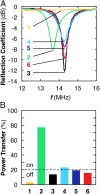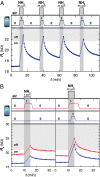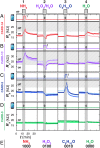Wireless gas detection with a smartphone via rf communication
- PMID: 25489066
- PMCID: PMC4280584
- DOI: 10.1073/pnas.1415403111
Wireless gas detection with a smartphone via rf communication
Abstract
Chemical sensing is of critical importance to human health, safety, and security, yet it is not broadly implemented because existing sensors often require trained personnel, expensive and bulky equipment, and have large power requirements. This study reports the development of a smartphone-based sensing strategy that employs chemiresponsive nanomaterials integrated into the circuitry of commercial near-field communication tags to achieve non-line-of-sight, portable, and inexpensive detection and discrimination of gas-phase chemicals (e.g., ammonia, hydrogen peroxide, cyclohexanone, and water) at part-per-thousand and part-per-million concentrations.
Keywords: NFC; RFID; nanomaterials; sensor; wireless.
Conflict of interest statement
Conflict of interest statement: A patent has been filed on this technology.
Figures




References
-
- Chen A, Chatterjee S. Nanomaterials based electrochemical sensors for biomedical applications. Chem Soc Rev. 2013;42(12):5425–5438. - PubMed
-
- Kirsch J, Siltanen C, Zhou Q, Revzin A, Simonian A. Biosensor technology: Recent advances in threat agent detection and medicine. Chem Soc Rev. 2013;42(22):8733–8768. - PubMed
-
- Hakim M, et al. Volatile organic compounds of lung cancer and possible biochemical pathways. Chem Rev. 2012;112(11):5949–5966. - PubMed
Publication types
MeSH terms
Substances
Grants and funding
LinkOut - more resources
Full Text Sources
Other Literature Sources

